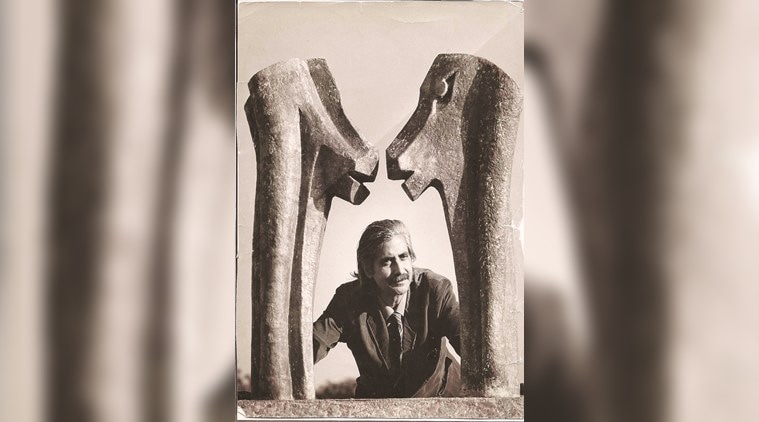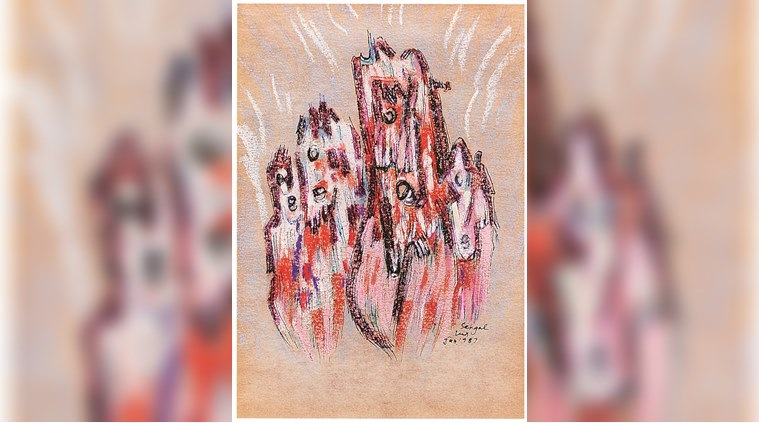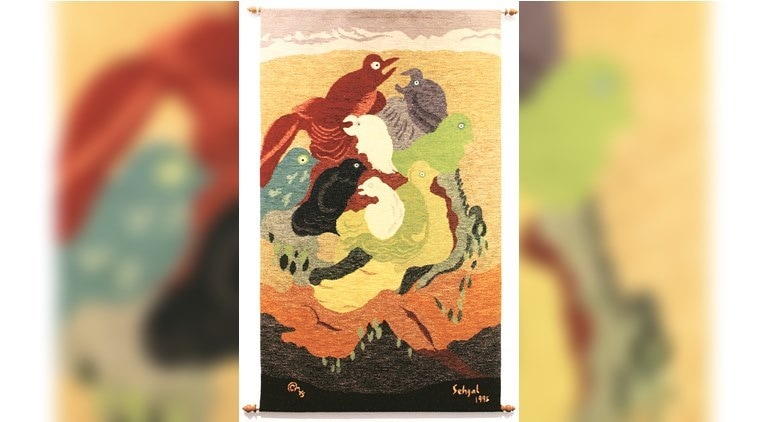 A portrait of Amarnath Sehgal with his work Friends 2.
A portrait of Amarnath Sehgal with his work Friends 2.
A year before she became the Prime Minister of India, in 1965, Indira Gandhi wrote a letter to sculptor Amarnath Sehgal, seeking his advice on how to regulate the statues of Jawaharlal Nehru that were being erected across the country in his memory. “Besides being devoid of artistic value, they hardly do justice to the man who is thus sought to be honoured,” she wrote to Sehgal. We do not know how Sehgal responded to this, but we do know that the Delhi-based artist was often consulted for government projects and also handled several of them himself. A recently opened space in Delhi, dedicated to Sehgal’s works, bears testimony to this. Among other works, the 1,550 sq feet space also has Sehgal’s own tribute to Nehru — a bronze sculpture with a flower blooming at its centre.
“The government was one of his patrons. He was a quintessential Partition artist who hasn’t got his due. He wasn’t very active in the art circle in India but travelled the world to showcase his art,” says curator Shruthi Isaac. Working on archiving the private collection for over two years now, Isaac has pulled out the material from over 200 cardboard boxes packed after Sehgal’s demise in 2007. The showcase, notes Sehgal’s son, Rajan, introduces the artist to the connoisseurs through his artworks and personal memorabilia. “He continued to work till the very end and this is a means to continue his legacy. We will keep rotating the display,” says Rajan.
 Some of Sehgal’s other works on display at the museum in Delhi.
Some of Sehgal’s other works on display at the museum in Delhi.
The creator of several public works — including the bronze sculpture, The Captive, installed on Robben Island, Cape Town, and the stone sculpture Aiming For Excellence at the DDA Yamuna Sports Complex in Delhi — Sehgal is best remembered for his 13-year-long legal battle with the Indian government. In 1957, he was commissioned a 140×40 feet bronze sculpture by Vigyan Bhavan. Installed in 1962, it was removed during the renovations in 1979 and put in storage. Subsequently, Sehgal filed a case against the government, seeking damages. The 2005 judgment upheld the moral right of the artist to his work and the government was asked to return his mural. The proceedings do find mention in the space here, in articles and letters. However, the emphasis is on the evolution of his art, and his thought process.
At the entrance are photographs of Sehgal with several luminaries, from the then Secretary-General of the United Nations Javier Perez de Cuellar, to French president François Mitterrand, Prime Minister Atal Bihari Vajpayee and President APJ Abdul Kalam.
Born in Campbellpur in North Pakistan, the trained engineer migrated to the Kangra-Kullu valley during the Partition, having witnessed mass killings and riots, the trauma of which remained with him throughout. “Several have managed to disassociate the emotion from their works but Sehgal never moves out of it,” says Isaac. She adds how his works reflected pain and displacement. After completing his art education at the New York University, Sehgal moved back to India in the early ’50s, working in villages and for the revival of traditional art forms. So, a tapestry in wool dating back to 1995, done with the Weavers Guild, Isaac notes, was created over several decades, with the pattern first sketched on a 1970 pencil-on-paper, followed by mixed media on paper in hues that were woven in the tapestry. Likewise, a 1960 oil was sketched on paper in 1955, when, Isaac shares, Sehgal was working in the rural areas.

Born in Campbellpur in North Pakistan, the trained engineer migrated to the Kangra-Kullu valley during the Partition, having witnessed mass killings and riots, the trauma of which remained with him throughout.
Several of his sketches and paintings are clubbed together in thematic sets that demonstrate his skill in these mediums, asserting that even though Sehgal is primarily known for his sculptures, he was also adept at other mediums. In a series dedicated to Lord Ganesha, he paints the various virtues associated with the elephant god — the portrayals range from him splashing water with his trunk, to dancing in ecstasy. The frames under “Human Heads” range from purely figurative to abstract, while in “Cityscapes and Mindscapes”, Sehgal has painted urban surroundings.
But the sculptures on display showcase why Sehgal is known as a master sculptor: such as the bronze, titled Soothing Hand, and the outdoor piece, titled Concept to A Monument to Peace, which has been etched with the words “Ishwar, Allah tere naam”, reflecting Sehgal’s desire for unity.
To borrow his own words from the film Amarnath Sehgal – A Portrait, produced by UNESCO: “My work has several rhymitical influences, whether it is purely aesthetic or humanist or has some emotional connotation, because that rhythm is part of our heritage. I am not concerned with anything that is angular. I am concerned with something that is continuous and rhythm has a continuity.”
Address: J-23, Jangpura Extension,
Delhi. Entry by appointment.
Contact: speak@amarnathsehgal.com